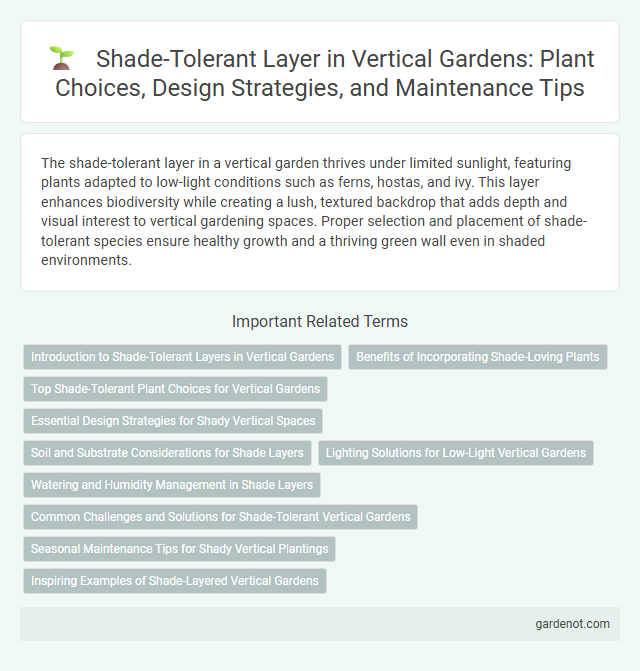The shade-tolerant layer in a vertical garden thrives under limited sunlight, featuring plants adapted to low-light conditions such as ferns, hostas, and ivy. This layer enhances biodiversity while creating a lush, textured backdrop that adds depth and visual interest to vertical gardening spaces. Proper selection and placement of shade-tolerant species ensure healthy growth and a thriving green wall even in shaded environments.
Introduction to Shade-Tolerant Layers in Vertical Gardens
Shade-tolerant layers in vertical gardens consist of plants adapted to low-light conditions, enhancing greenery in indoor or shaded outdoor spaces. These layers improve air quality by filtering pollutants and provide aesthetic texture through diverse foliage shapes and colors. Selecting species like ferns, philodendrons, or hostas ensures a thriving vertical ecosystem in areas with limited sunlight.
Benefits of Incorporating Shade-Loving Plants
Incorporating shade-loving plants in a vertical garden enhances biodiversity by supporting species that thrive in lower light conditions, promoting a balanced ecosystem. These shade-tolerant layers improve microclimate regulation, reducing temperature fluctuations and maintaining humidity levels that benefit the overall garden health. Utilizing plants like ferns, mosses, and begonias helps maximize space efficiency while providing aesthetic variety and reducing water consumption through natural shade protection.
Top Shade-Tolerant Plant Choices for Vertical Gardens
Top shade-tolerant plant choices for vertical gardens include ferns, philodendrons, and begonias, which thrive in low-light conditions and add lush greenery. These plants boast strong adaptability to shaded environments, maintaining vibrant foliage and promoting healthy vertical growth. Incorporating shade-loving varieties ensures sustained aesthetic appeal and biodiversity in vertical garden layers exposed to limited sunlight.
Essential Design Strategies for Shady Vertical Spaces
Shade-tolerant plants such as ferns, mosses, and philodendrons thrive in vertical gardens with limited sunlight by leveraging essential design strategies like maximizing indirect light through reflective surfaces and incorporating moisture-retentive substrates to support plant health. Strategic placement of shade-adapted species in the lower and middle layers ensures optimal growth while maintaining air circulation to reduce humidity-related issues. Utilizing vertical garden systems with adjustable panels or modular components allows for customization based on light availability, enhancing the overall sustainability of shady vertical spaces.
Soil and Substrate Considerations for Shade Layers
Selecting the right soil and substrate for shade-tolerant layers in a vertical garden is crucial for optimal plant health and growth. A well-draining, nutrient-rich substrate with high organic matter supports moisture retention without waterlogging, essential for shade-loving plants such as ferns and hostas. Incorporating lightweight materials like coconut coir or peat moss enhances aeration and root development in low-light conditions, ensuring a stable environment for shade layer vegetation.
Lighting Solutions for Low-Light Vertical Gardens
Shade-tolerant plants in vertical gardens thrive under innovative lighting solutions like full-spectrum LED grow lights, which mimic natural sunlight to promote photosynthesis in low-light environments. Adjustable light intensity and spectrum settings enhance plant growth by targeting specific wavelengths crucial for chlorophyll absorption in shaded areas. Integrating energy-efficient fixtures with timers ensures optimal light exposure, sustaining healthy foliage and vibrant vertical layers despite limited natural light.
Watering and Humidity Management in Shade Layers
Efficient watering techniques in shade-tolerant layers of vertical gardens prevent waterlogging by using drip irrigation systems tailored to moisture-loving plants like ferns and mosses. Maintaining optimal humidity levels between 60-80% supports healthy growth and reduces disease risks in these shaded microclimates. Incorporating moisture-retentive substrates such as coconut coir enhances water retention for consistent hydration without oversaturation.
Common Challenges and Solutions for Shade-Tolerant Vertical Gardens
Shade-tolerant vertical gardens often face challenges such as limited light availability, which can stunt plant growth and reduce vibrancy. To overcome these issues, selecting plant species like ferns, ivies, and begonias that thrive in low-light conditions is essential, along with optimizing artificial lighting and ensuring proper irrigation systems to maintain moisture without overwatering. Regular maintenance to prevent mold and pests further supports healthy growth in shaded vertical garden layers.
Seasonal Maintenance Tips for Shady Vertical Plantings
Shade-tolerant plants in vertical gardens require specific seasonal maintenance to thrive, including regular pruning to prevent overcrowding and improve air circulation. Monitoring soil moisture levels is crucial during dry spells to avoid dehydration, as shaded areas often retain less moisture than expected. Applying mulch and using slow-release fertilizers can enhance nutrient availability, supporting healthy growth throughout changing seasons.
Inspiring Examples of Shade-Layered Vertical Gardens
Shade-tolerant plants such as ferns, mosses, and philodendrons thrive in vertical gardens designed to maximize limited sunlight, creating lush, green walls even in dim environments. Notable examples include the Cloud Garden in Toronto, which expertly uses multiple shade layers to foster biodiversity and aesthetic appeal. These innovative vertical garden designs demonstrate how adapting plant selection to light conditions enhances urban green spaces while promoting sustainability.
Shade-tolerant layer Infographic

 gardenot.com
gardenot.com